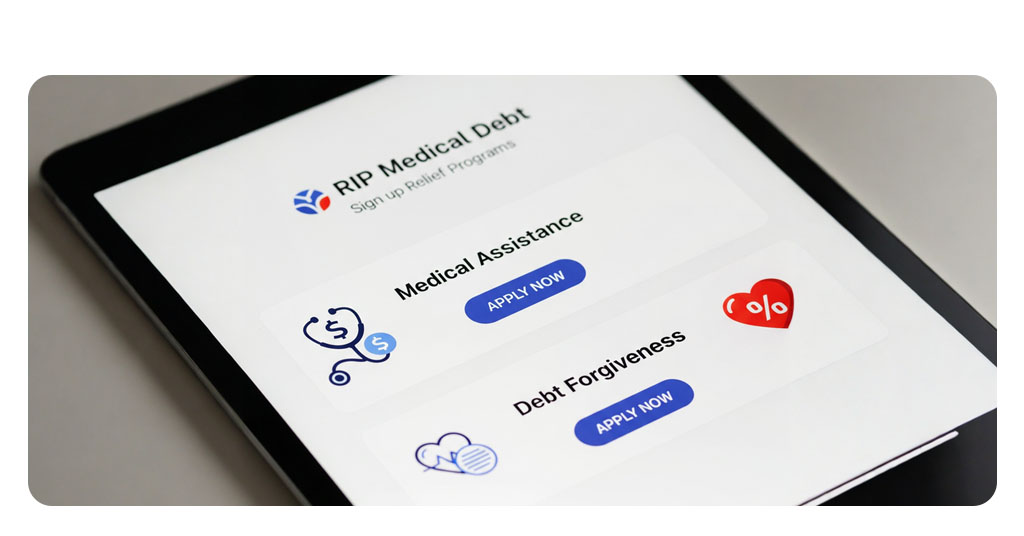Medical Debt Relief can ease the burden of overwhelming healthcare costs through programs, nonprofit aid, and legal support. Across the U.S., many of these resources are still available for application, and the process is often easier than people expect.
From hospital-based financial assistance to state-run programs and charity organizations, support is more accessible than ever. You may also benefit from legal protections that prevent aggressive collection or offer payment restructuring. Understanding your options can be the first step toward regaining control over your finances and protecting your well-being.
- Free Online Medical Terminology Courses
- Online Medical Billing and Coding Courses
- The 5 Essential Remote Medical Care Apps
What Medical Debt Relief Programs Are Still Active?
Millions of Americans struggle with overwhelming medical bills, but relief programs can help reduce or even eliminate this debt. Here are the most effective options available today:
Government & Hospital Financial Assistance
- Hospital Charity Care Programs – Many hospitals offer free or reduced-cost care based on income;
- Medicaid Retroactive Coverage – May cover unpaid bills from the past 3 months if you qualify;
- State-Specific Relief – Some states (like North Carolina) have additional programs.
Explore Medical Debt Relief Resources Online
National Debt Relief offers guides and tools to help individuals understand and reduce their medical debt, including negotiation strategies and debt relief options tailored to personal financial situations.
CMS (Centers for Medicare & Medicaid Services) provides official information on patient rights, hospital financial assistance policies, and how to request help with unaffordable medical bills through hospitals or state-funded programs.
Nonprofit Medical Debt Forgiveness
- Undue Medical Debt – Buys and forgives medical debt for low-income individuals;
- Dollar For – Helps patients apply for hospital financial aid.
Federal & Local Assistance
- USA.gov Medical Bill Help – Lists state and federal aid programs;
- 211.org – Connects you with local medical bill assistance.
Who Can Apply and How It Works
Medical debt relief programs are often available to low- and middle-income individuals, the uninsured, or those facing financial hardship due to healthcare costs.
Eligibility varies by provider, but many hospitals and state agencies offer financial assistance.
Understanding who qualifies and how to apply is the first step toward managing overwhelming bills.
With the right documentation, you could access significant reductions—or full forgiveness—of your medical debt.
Eligibility Requirements
- Low-income households (varies by program);
- Uninsured or underinsured patients;
- Those with high medical debt relative to income.
How to Apply
- Gather Documents – Proof of income, medical bills, and insurance denials;
- Contact the Hospital’s Billing Department – Ask about financial assistance policies;
- Submit Applications – To nonprofits like Dollar For or government programs.
How to Use Nonprofits to Eliminate Debt
Several nonprofit organizations work specifically to erase medical debt for people in need. Groups like RIP Medical Debt purchase unpaid bills and forgive them, while others offer negotiation help or financial counseling.
These nonprofits aim to ease the burden on families struggling with healthcare expenses. By partnering with them, you may find relief without going deeper into financial stress.
Undue Medical Debt
- How it works: purchases medical debt in bulk and forgives it;
- Who qualifies: low-income individuals (no application needed—debt is erased automatically if selected).
Dollar For
- How it works: helps patients apply for hospital financial aid to get bills reduced or waived;
- Who qualifies: anyone struggling with hospital bills.
BenefitsCheckUp
- How it works: finds additional state and local assistance programs.
Legal Rights You Have Against Medical Collections
Consumers have legal protections against aggressive medical debt collections under federal and state laws. The Fair Debt Collection Practices Act (FDCPA), for instance, limits how and when collectors can contact you.
You also have the right to dispute debts and request validation before paying. Knowing these rights can help you navigate debt collection safely and avoid harassment or unjust claims.
Dispute Errors
- Under the Fair Credit Reporting Act (FCRA), you can challenge incorrect medical debt on your credit report.
Stop Harassment
- Debt collectors cannot threaten you or call excessively under the Fair Debt Collection Practices Act (FDCPA).
Wait for Insurance Payments
- By law, hospitals must wait at least 30 days before sending bills to collections if insurance is processing claims.

Long-Term Tips to Avoid Future Medical Debt
Medical expenses are a leading cause of financial hardship in the U.S., but proactive planning can help you avoid crushing debt.
These three strategies can significantly reduce your healthcare costs while maintaining quality care.
Negotiate Medical Bills Before Treatment
Why it works:
Healthcare providers often have flexible pricing and may offer substantial discounts if you ask. A 2023 JAMA study found patients who negotiated bills saved 30-50% on average.
How to do it effectively:
- Request pricing upfront:
- Ask for a Good Faith Estimate (required under federal law since 2022);
- Compare costs between providers using tools like Healthcare Bluebook.
- Negotiation tactics:
- Offer to pay cash upfront for 20-40% discounts;
- Ask about sliding scale fees based on income;
- Propose interest-free payment plans (many hospitals offer 12-24 months).
- Get agreements in writing before procedures.
Example:
A $3,000 MRI might be reduced to $1,800 with cash payment, or $125/month for 24 months.
Maximize Insurance Options Through Medicaid/ACA
Key facts:
- 25% of uninsured Americans qualify for free or low-cost coverage, but don’t enroll;
- ACA plans can cost less than $10/month after subsidies.
Action steps:
Check Medicaid eligibility year-round at HealthCare.gov
- Income limits recently expanded in many states.
Special Enrollment Periods allow sign-ups after:
- Job loss;
- Marriage/divorce;
- Having a baby.
Compare ACA plans carefully:
- Lower premiums may mean higher deductibles;
- Ensure your doctors/hospitals are in-network.
Pro tip: Free enrollment help is available through:
- Local “navigators”;
- Community health centers;
- Nonprofits like Get Covered America.
Choose the Right Care Setting
Cost differences (average):
| Service | Typical Cost |
| Emergency Room | $1,500-$3,000 |
| Urgent Care | $150-$300 |
| Telemedicine | $0-$75 |
| Retail Clinic (CVS/Walgreens) | $100-$150 |
When to use each:
- ER: life-threatening conditions (chest pain, severe bleeding);
- Urgent care: broken bones, stitches, severe flu;
- Telehealth: cold/flu, rashes, medication refills;
- Retail clinics: vaccinations, strep tests.
Money-saving alternatives:
- Free/low-cost clinics (find via 211.org);
- Hospital outpatient departments (often cheaper than ER);
- Preventive care (fully covered under most insurance).
Implementing These Strategies
Before care:
- Verify insurance coverage;
- Get cost estimates;
- Schedule non-urgent procedures early in the year (after meeting deductible).
Aftercare:
- Review bills for errors (up to 80% contain mistakes);
- Appeal denied insurance claims.
Ongoing:
- Build an emergency health fund (even $500 helps);
- Use tax-advantaged accounts (HSAs/FSAs).
For those already in debt, combine these prevention tips with the relief programs mentioned earlier. Remember—being an informed healthcare consumer is your best defense against medical debt.
Next steps:
- Bookmark HealthCare.gov for insurance options;
- Save local urgent care contacts in your phone;
- Start a medical negotiation folder for all healthcare correspondence.
Take Action Today
If you’re struggling with medical debt, don’t ignore it—apply for relief programs, negotiate bills, and use nonprofit help.
For more financial assistance resources, visit USA.gov or check our guide on Social Security changes.





